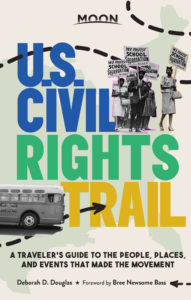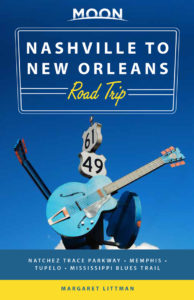Natchez
Before the Civil War, Natchez (pronounced “NATCH-iss,” rhymes with “matches”) had the most millionaires per capita in the United States, and it shows. Natchez has more than 500 antebellum structures inside the city limits, with innumerable white columns and rich smorgasbord of Italian marble, imported crystal, and sterling silver. So much antebellum finery still exists because Natchez, unlike Vicksburg, surrendered to Grant’s army almost without a fight. Anti-Yankee sentiment may, in fact, run higher now than during the war, for Natchez was vehemently opposed to the Confederacy and outspokenly against Mississippi’s secession from the Union. Since Natchez was second only to New Orleans as social and cultural capital of a region with two-thirds of the richest people in America, most of whom owed their wealth to cotton picked by enslaved people, its support of the Union might seem a little incongruous.
Of course, such apparent contradictions should come as no surprise from a community raised with genteel cotillions and the Mississippi’s busiest
red-light district side-by-side. Once-disreputable Natchez Under-the-Hill, where the most famous brothel in the South was destroyed by a fire in 1992, is today but a single gentrified block of riverfront bars and restaurants.
As befits the place that originated the concept, the annual Natchez Pilgrimages (held for four weeks in late spring and around two weeks in the fall) are longer than you will typically find elsewhere. Antebellum mansions are open to the public, hoop skirts and brass-buttoned waistcoats abound, and musical diversions like the Historic Natchez Tableaux are held almost nightly. Among the most fascinating homes open year-round is the one that didn’t get finished: Longwood, on Lower Woodville Road, is the nation’s largest octagonal house, capped by a red onion dome. Its grounds are fittingly Gothic too, with moss-dripping tree limbs, a sunken driveway, and the family cemetery out in the woods. Information on the Pilgrimages, other house tours ($15 and up per house), and the chance to stay in one of many historic B&Bs all comes from the same group, Natchez Pilgrimage Tours (601/446-6631 or 800/647-6742), which also runs horse-drawn carriage tours.
Southern history doesn’t merely comprise those Greek Revival heaps and their Gone with the Wind stereotypes. Natchez, for example, had a large population of free Blacks, and their story is told in downtown’s Museum of African American History and Culture (301 Main St., 601/445-0728, 10am-4:30pm Mon.-Fri., 10am-2pm Sat.), in the old post office, where you’ll also find interesting Black Heritage walking-tour brochures. A large Jewish section in the City Cemetery (follow signs for the National Cemetery; City Cemetery is along the way) also furnishes evidence of the South’s tapestried past. The marble statuary and decorative wrought iron offer a pleasant outdoor respite for weary mansion-goers, too.
Where to Eat and Stay in Natchez
As befits a place with a strong tourism trade, Natchez has some great places to eat. Natchez is almost the southern extremity of the Tamale Belt, and you can sit down to a dish of them at Fat Mama’s Tamales (303 S. Canal St., 601/442-4548, $11 for a dozen tamales). Fat Mama’s also serves killer Knock You Naked frozen margaritas, a combination that draws large crowds on summer nights.
If you prefer fried catfish, po’boys, and chocolate shakes, head down to The Malt Shop (601/445-4843), where Doctor Martin Luther King Street (US-61 Business) dead-ends into Homochitto Street. For a change of pace, try Pearl Street Pasta (105 S. Pearl St., 601/442-9284), just off Main Street, which has a menu that is eclectic, reasonably priced, and laced with vegetables that haven’t been boiled to oblivion. Modern and spacious Roux 61 (453 US-61, 601/445-0004) for huge portions of fresh-fried Mississippi catfish and Louisiana Cajun fare.
Accommodations in Natchez include a few familiar names scattered along US-61 and US-84 both north and south of downtown. For a more memorable experience, consider staying the night in one of those historic mansions, many of which do double duty as B&Bs.
Related Travel Guides
Map of the Great River Road in Mississippi

















